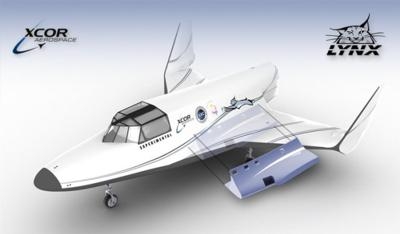Thu, Sep 13, 2012
Critical Component Designed For 'Tens Of Thousands' Of Flights
XCOR Aerospace announced Tuesday that the Lynx Mark I suborbital reusable launch vehicle (RLV) wing strake assemblies will be manufactured by FiberDyne Advanced Composites of Tukwila, WA. The Lynx wing strakes are critical structural components that attach the Lynx fuselage to the wings and hold kerosene fuel, attachment points for the main landing gear, and bays for the vehicle's reaction control thrusters.

The strakes have been designed by XCOR to rigorous design standards that will enable a craft to perform tens of thousands of flights to and from suborbital altitudes exceeding 100 kilometers. The strake has undergone an iterative design process by XCOR engineers and outside independent third party structural and thermal analysis experts from Quartus Engineering in San Diego.
FiberDyne was selected after a thorough competitive selection process that emphasized past experience, ability to manufacture complex carbon fiber structures used in safety critical pressurized applications, schedule and value. FiberDyne is teamed with tool maker Sierra Technical Services of Mojave, CA. “FiberDyne really stepped up for us with the wing strakes,” said Jeff Greason, Co-Founder and President of XCOR, “we are asking a lot in terms of performance and schedule from their team, and we’ve been impressed thus far with the results. It is very exciting to see our designs we’ve worked on for so many years coming to life before us.”
“FiberDyne is proud and honored to have been selected as a primary supplier for XCOR,” said Steven Zack, Founder and President of FiberDyne, “with our sights set on the future growth and success of XCOR Lynx program and private space development as a whole. Our motto at FiberDyne is Lighter, Faster, and Stronger… All of which will be applied to the Lynx program. ”
The wing strakes will be installed on the Lynx Mark I which is the prototype of the Lynx family of suborbital RLVs from XCOR. All Lynx vehicles will be able to seat an astronaut pilot and a single spaceflight participant, or an astronaut pilot and large scientific payload. The "Lynx Mark II" is the designated name for the Lynx production model and is designed to fly to space up to four times per day with similar payload as the Lynx Mark I but with significantly improved performance.
XCOR has already announced Lynx Mark II wet lease agreements with emerging space lines. XCOR has already announced the signing of a wet lease definitive agreement for Lynx Mark II operations in the island nation of Curacao and plans for XCOR-led operations at two U.S. sites, Mojave, California and Kennedy Space Center Shuttle Landing Facility in Florida, pending final NASA approvals.
(Image provided by XCOR)
More News
Circle To Runway (Runway Number) Used by ATC to inform the pilot that he/she must circle to land because the runway in use is other than the runway aligned with the instrument appr>[...]
Aero Linx: National Aviation Safety Foundation (NASF) The National Aviation Safety Foundation is a support group whose objective is to enhance aviation safety through educational p>[...]
At Altitude Of About 250-300 Ft Agl, The Airplane Experienced A Total Loss Of Engine Power On November 6, 2024, at 1600 central standard time, a De Havilland DHC-1, N420TD, was inv>[...]
From 2009 (YouTube Edition): Three Hour Flight Was 'Flawless' -- At Least, Until Mother Nature Intervened For anyone who loves the aviation business, this was a VERY good day. Afte>[...]
Also: AMA Names Tyler Dobbs, More Falcon 9 Ops, Firefly Launch Unsuccessful, Autonomous F-16s The Air Force has begun ground testing a future uncrewed jet design in a milestone tow>[...]
 ANN's Daily Aero-Term (05.05.25): Circle To Runway (Runway Number)
ANN's Daily Aero-Term (05.05.25): Circle To Runway (Runway Number) ANN's Daily Aero-Linx (05.05.25)
ANN's Daily Aero-Linx (05.05.25) NTSB Prelim: De Havilland DHC-1
NTSB Prelim: De Havilland DHC-1 Classic Aero-TV: The Boeing Dreamliner -- Historic First Flight Coverage
Classic Aero-TV: The Boeing Dreamliner -- Historic First Flight Coverage Airborne-NextGen 05.06.25: AF Uncrewed Fighters, Drones v Planes, Joby Crew Test
Airborne-NextGen 05.06.25: AF Uncrewed Fighters, Drones v Planes, Joby Crew Test



